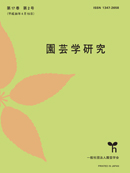Volume 19, Issue 2
Displaying 1-12 of 12 articles from this issue
- |<
- <
- 1
- >
- >|
REVIEW
-
2020Volume 19Issue 2 Pages 97-114
Published: 2020
Released on J-STAGE: June 30, 2020
Download PDF (3868K)
REPORTS
Breeding & Germplasm Resources
-
2020Volume 19Issue 2 Pages 115-120
Published: 2020
Released on J-STAGE: June 30, 2020
Download PDF (4833K) -
2020Volume 19Issue 2 Pages 121-129
Published: 2020
Released on J-STAGE: June 30, 2020
Download PDF (2184K) -
2020Volume 19Issue 2 Pages 131-139
Published: 2020
Released on J-STAGE: June 30, 2020
Download PDF (1866K) -
2020Volume 19Issue 2 Pages 141-149
Published: 2020
Released on J-STAGE: June 30, 2020
Download PDF (6390K) -
2020Volume 19Issue 2 Pages 151-158
Published: 2020
Released on J-STAGE: June 30, 2020
Download PDF (6088K) -
2020Volume 19Issue 2 Pages 159-166
Published: 2020
Released on J-STAGE: June 30, 2020
Download PDF (2172K)
Soil Management, Fertilization & Irrigation
-
2020Volume 19Issue 2 Pages 167-174
Published: 2020
Released on J-STAGE: June 30, 2020
Download PDF (1828K)
Crop Production & Cropping Type
-
2020Volume 19Issue 2 Pages 175-181
Published: 2020
Released on J-STAGE: June 30, 2020
Download PDF (1877K)
Growth Regulation
-
2020Volume 19Issue 2 Pages 183-188
Published: 2020
Released on J-STAGE: June 30, 2020
Download PDF (1988K)
NEW TECHNOLOGY
-
2020Volume 19Issue 2 Pages 189-195
Published: 2020
Released on J-STAGE: June 30, 2020
Download PDF (5204K)
NEW CULTIVAR
-
2020Volume 19Issue 2 Pages 197-204
Published: 2020
Released on J-STAGE: June 30, 2020
Download PDF (1097K)
- |<
- <
- 1
- >
- >|
